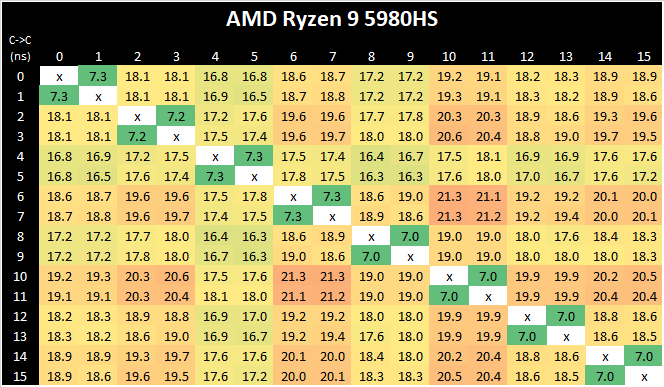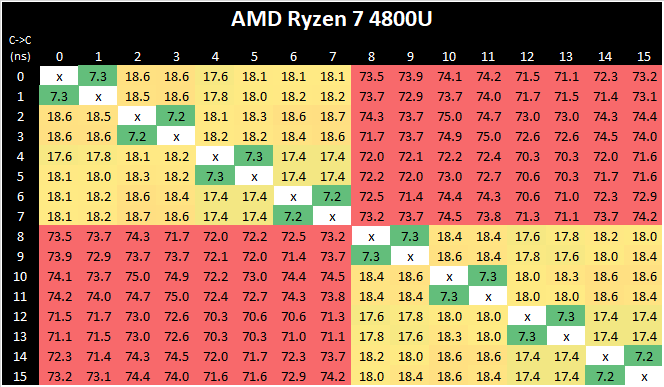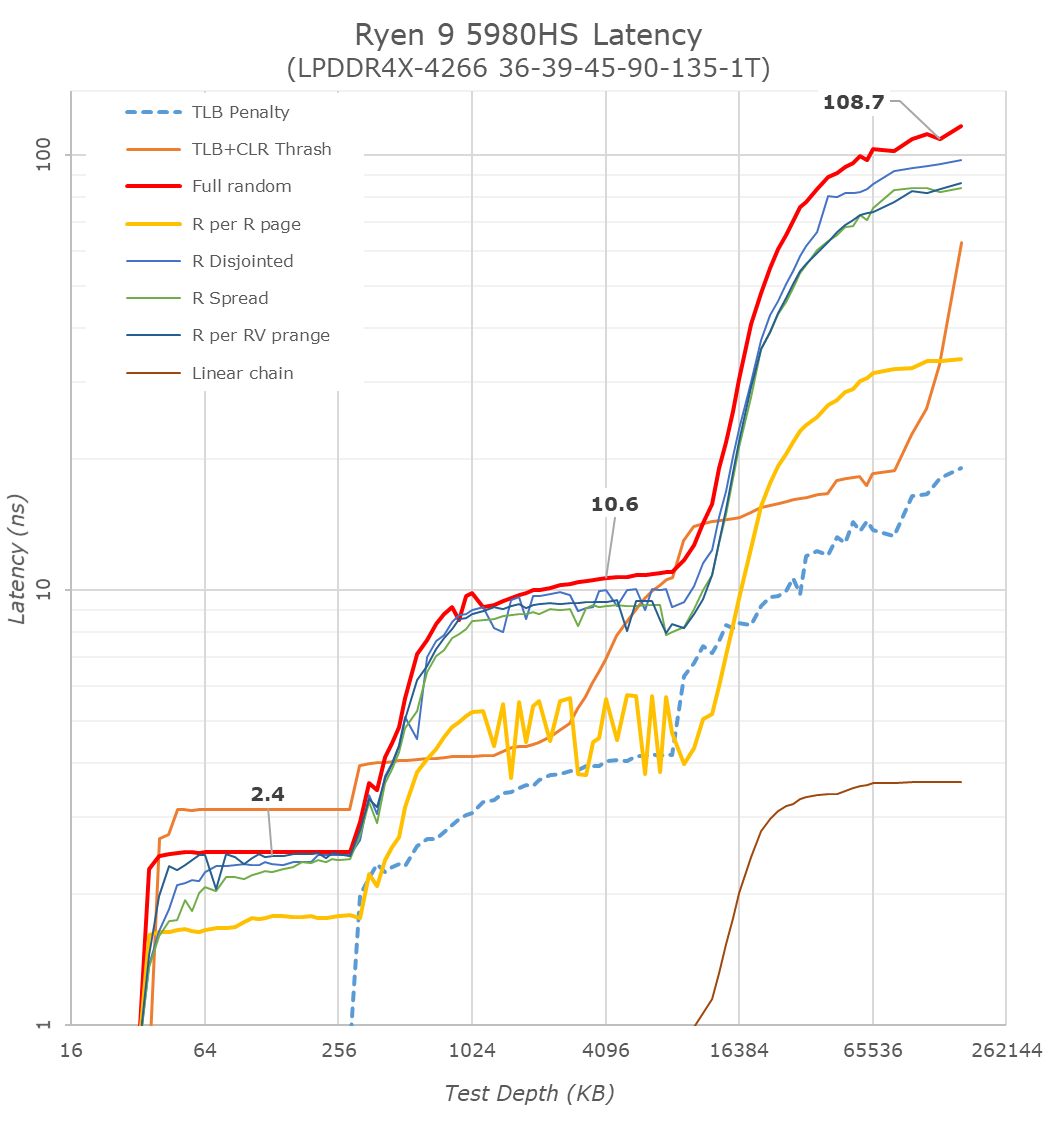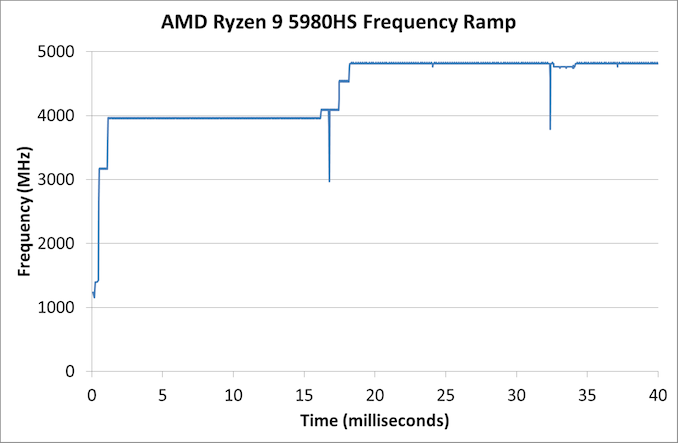AMD Ryzen 9 5980HS Cezanne Review: Ryzen 5000 Mobile Tested
by Dr. Ian Cutress on January 26, 2021 9:00 AM EST- Posted in
- CPUs
- AMD
- Vega
- Ryzen
- Zen 3
- Renoir
- Notebook
- Ryzen 9 5980HS
- Ryzen 5000 Mobile
- Cezanne
CPU Tests: Microbenchmarks
Core-to-Core Latency
As the core count of modern CPUs is growing, we are reaching a time when the time to access each core from a different core is no longer a constant. Even before the advent of heterogeneous SoC designs, processors built on large rings or meshes can have different latencies to access the nearest core compared to the furthest core. This rings true especially in multi-socket server environments.
But modern CPUs, even desktop and consumer CPUs, can have variable access latency to get to another core. For example, in the first generation Threadripper CPUs, we had four chips on the package, each with 8 threads, and each with a different core-to-core latency depending on if it was on-die or off-die. This gets more complex with products like Lakefield, which has two different communication buses depending on which core is talking to which.
If you are a regular reader of AnandTech’s CPU reviews, you will recognize our Core-to-Core latency test. It’s a great way to show exactly how groups of cores are laid out on the silicon. This is a custom in-house test built by Andrei, and we know there are competing tests out there, but we feel ours is the most accurate to how quick an access between two cores can happen.
AMD’s move from a dual 4-core CCX design to a single larger 8-core CCX is a key characteristic of the new Zen3 microarchitecture. Beyond aggregating the separate L3’s together for a large single pool in single-threaded scenarios, the new Cezanne-based mobile SoCs also completely do away with core-to-core communications across the SoC’s infinity fabric, as all the cores in the system are simply housed within the one shared L3.
What’s interesting to see here is also that the new monolithic latencies aren’t quite as flat as in the previous design, with core-pair latencies varying from 16.8ns to 21.3ns – probably due to the much larger L3 this generation and more wire latency to cross the CCX, as well as different boost frequencies between the cores. There has been talk as to the exact nature of the L3 slices, whether they are connected in a ring or in an all-to-all scenario. AMD says it is an 'effective' all-to-all, although the exact topology isn't quite. We have some form of mesh with links, beyond a simple ring, but not a complete all-to-all design. This will get more complex should AMD make these designs larger.
Cache-to-DRAM Latency
This is another in-house test built by Andrei, which showcases the access latency at all the points in the cache hierarchy for a single core. We start at 2 KiB, and probe the latency all the way through to 256 MB, which for most CPUs sits inside the DRAM (before you start saying 64-core TR has 256 MB of L3, it’s only 16 MB per core, so at 20 MB you are in DRAM).
Part of this test helps us understand the range of latencies for accessing a given level of cache, but also the transition between the cache levels gives insight into how different parts of the cache microarchitecture work, such as TLBs. As CPU microarchitects look at interesting and novel ways to design caches upon caches inside caches, this basic test proves to be very valuable.
As with the Ryzen 5000 Zen3 desktop parts, we’re seeing extremely large changes in the memory latency behaviour of the new Cezanne chip, with AMD changing almost everything about how the core works in its caches.
At the L1 and L2 regions, AMD has kept the cache sizes the same at respectively 32KB and 512KB, however depending on memory access pattern things are very different for the resulting latencies as the engineers are employing more aggressive adjacent cache line prefetchers as well as employing a brand-new cache line replacement policy.
In the L3 region from 512KB to 16 MB - well, the fact that we’re seeing this cache hierarchy quadrupled from the view of a single core is a major benefit of cache hit rates and will greatly benefit single-threaded performance. The actual latency in terms of clock cycles has gone up given the much larger cache structure, and AMD has also tweaked and changes the dynamic behaviour of the prefetchers in this region.
In the DRAM side of things, the most visible change is again this much more gradual latency curve, also a result of Zen3’s newer cache line replacement policy. All the systems tested here feature LPDDR4X-4266 memory, and although the new Cezanne platform has a slight advantage with the timings, it ends up around 13ns lower latency at the same 128MB test depth point into DRAM, beating the Renoir system and tying with Intel’s Tiger Lake system.
Frequency Ramping
Both AMD and Intel over the past few years have introduced features to their processors that speed up the time from when a CPU moves from idle into a high powered state. The effect of this means that users can get peak performance quicker, but the biggest knock-on effect for this is with battery life in mobile devices, especially if a system can turbo up quick and turbo down quick, ensuring that it stays in the lowest and most efficient power state for as long as possible.
Intel’s technology is called SpeedShift, although SpeedShift was not enabled until Skylake.
One of the issues though with this technology is that sometimes the adjustments in frequency can be so fast, software cannot detect them. If the frequency is changing on the order of microseconds, but your software is only probing frequency in milliseconds (or seconds), then quick changes will be missed. Not only that, as an observer probing the frequency, you could be affecting the actual turbo performance. When the CPU is changing frequency, it essentially has to pause all compute while it aligns the frequency rate of the whole core.
We wrote an extensive review analysis piece on this, called ‘Reaching for Turbo: Aligning Perception with AMD’s Frequency Metrics’, due to an issue where users were not observing the peak turbo speeds for AMD’s processors.
We got around the issue by making the frequency probing the workload causing the turbo. The software is able to detect frequency adjustments on a microsecond scale, so we can see how well a system can get to those boost frequencies. Our Frequency Ramp tool has already been in use in a number of reviews.
Our frequency ramp showcases that AMD does indeed ramp up from idle to a high speed within 2 milliseconds as per CPPC2. It does take another frame at 60 Hz (16 ms) to go up to the full turbo of the processor mind.














218 Comments
View All Comments
Meteor2 - Thursday, February 4, 2021 - link
Web JavaScript benchmarks really don't count for much. They certainly don't reflect the user experience of the web.DigitalFreak - Tuesday, January 26, 2021 - link
It's all about the money, and I'm pretty sure Intel is handing out more marketing funds and rebates than AMD. Most people don't care if they have Intel or AMD in their laptop.msroadkill612 - Tuesday, January 26, 2021 - link
Yes its about money and no Intels strategies dont seem to be hiding reality so well these days - OEMs are deserting their designs in droves.There is a deal breaking cost & power saving at the mainstream mobile sweet spot, where the APU delivers competent modern graphics w/o need of a DGPU.
Intel can only match amd graphics by adding a dgpu.
Deicidium369 - Wednesday, January 27, 2021 - link
"OEMs are deserting their designs in droves." Really? So now only 10:1 vs AMD designs?Deicidium369 - Wednesday, January 27, 2021 - link
Providing designs to OEMs and supplying most of the parts for a laptop - making it super easy for them to come to market with an Intel design... That's called smart business.Spunjji - Thursday, January 28, 2021 - link
That's not the same thing as marketing funds and rebates, which Intel also do - they even do it at the reseller level.So there's "smart business", then there's "buying marketshare", and then there's "outright bribery". Intel got fined for doing the last one, so now they mostly only do the first two - although it's a toss-up as to whether you think their contra-revenue scheme counted as option 2 or 3.
theqnology - Wednesday, January 27, 2021 - link
It's easy to compare them (M1 vs x86) on some metrics, but I think it is more nuanced than that. Do note that M1 is at 5nm, with size at around 120.5mm^2. The AMD parts are at 180mm^2 at 7nm. The M1 has 16 billion transistors versus 10.7 billion transistors for the Zen3 APUs. That is 49.5% more transistors in favor of M1.I think a huge part of the reason M1 performs so well in many benchmarks, are that it can target specific workloads, and offload it to specific hardware cores for specific accelerated performance at lower power consumption. It becomes easy for Apple to achieve such, I think, because this is all transparent from the application developers, as they control the entire hardware AND software stack, much like consoles performing at high-end GPU levels despite having less powerful GPU cores.
This is not a cost-effective approach, although not impossible for AMD and Intel. Also part of the reason why I think if M1 were put into cloud servers, it would not be cost-effective. There will be so much dedicated hardware accelerated cores that will not be put to use when M1 is deployed in the cloud.
That said, Apple M1 is a great feat. Hopefully, AMD can also achieve a similar feat (high efficiency accelerated processing) using their Infinity Fabric and glue, allowing them to continue focusing on their Zen cores while also uplifting ancillary workload performance. The big impediment here, would be the OS support, unless it becomes a standard.
GeoffreyA - Sunday, January 31, 2021 - link
An interesting thought and one I'd like to see reviewers looking into. Also, if it were possible to get Windows ARM running on the M1, that would be an insightful experiment, removing Apple's software layers out of the picture.Deicidium369 - Wednesday, January 27, 2021 - link
Intel is in premium laptops because they make it easy for the OEMs to make good designs - not only the "blueprints" but also high efficiency parts other than just the CPU. So an OEM has little to no R&D expense, and can roll out a great laptop.AMD should do the same - it's good business and would negate the reticence of the OEMs to invest in a smaller segment - not like this would have AMD selling more than Intel - but would improve their market presence in laptops significantly.
Spunjji - Thursday, January 28, 2021 - link
"AMD should do the same"I suspect they will once they have the funds to do so. You can't just bully your way into a market by copying the precise strategies of a company that's several times larger than you.